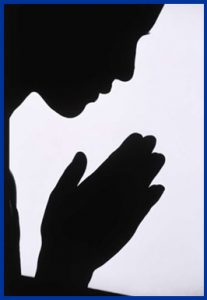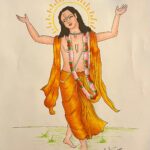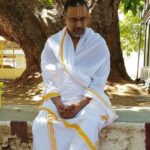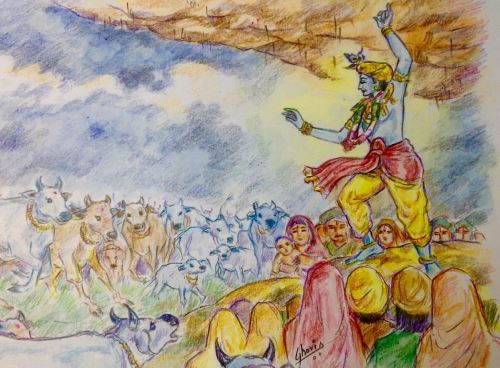Madhura Geetham – Sloka Series
“Athichoodi” is a type of poetic work (in Tamil) that comprises of a collection of one-line philosophical verses. HH Sri Sri Muralidhara Swamiji has composed a “Vedanta Athichoodi”, a poetic work that speaks of life’s most important principles. We had published the entire Vedanta Athichoodi and its overall meaning as part of our Madhura Geetham Sloka Series, earlier this year. Read that article here.
Each of the lines of this Athichoodi is extremely deep and contains a wealth of meaning. In our sloka series over the next few months, we will look at the meaning of each line of this work.
Oviyatthil anthamaDai!
In this eleventh verse – Oviyatthil anthamaDai – Sri Swamiji describes the goal of dhyana and in general, the goal of all spiritual paths, which is to culminate in the Divine Form. The Divine Form which, Sri Veda Vyasa says, is known by various terms like Brahman, Paramatma, or Bhagawan. Jnanis call this Supreme Being as Brahman, yogis call it Paramatma, and devotees brimming with love for the Lord call Him as Bhagavan.
 A novice might be confused by the different terminologies and may think that the nirguna (without attributes) Brahman is different from the saguna (with attributes) form. Only by the grace of the Lord, one understands that both nirguna and saguna are like the two sides of the same coin. Sri Sadasiva Brahmendral, who was a great jnani, sang in a kirtan, “Manasa sancharare, Brahmani” (Oh Mind! Dwell on the Supreme Brahman). And in the next line, he described this Supreme Brahman as having a peacock feather on its head (madashikhi pincchAlankrta chikurE) showing us that the Supreme Brahman and the Divine Form of Lord Krishna are verily the same.
A novice might be confused by the different terminologies and may think that the nirguna (without attributes) Brahman is different from the saguna (with attributes) form. Only by the grace of the Lord, one understands that both nirguna and saguna are like the two sides of the same coin. Sri Sadasiva Brahmendral, who was a great jnani, sang in a kirtan, “Manasa sancharare, Brahmani” (Oh Mind! Dwell on the Supreme Brahman). And in the next line, he described this Supreme Brahman as having a peacock feather on its head (madashikhi pincchAlankrta chikurE) showing us that the Supreme Brahman and the Divine Form of Lord Krishna are verily the same.
Sri Ramakrishna Paramahamsa, when describing the formless Brahman (nirguna brahman), compared it to an ocean and the different forms of the Lord (saguna form) as solid ice. Ice and water are made of the same basic elements but ice has extra attributes like shape, size, temperature, etc. Nirguna brahman (formless) has no attributes and is therefore beyond the realm of our senses and mind. Even the Vedas find it hard to describe the nirguna brahman. It only says ‘neti, neti’ (not this, not this). On the other hand, saguna murthi (the Divine Form) has attributes that can be perceived and understood to some extent by the senses.
For a jnani, culmination in the Divine Form means the death of the mind (mano nAsa) and merging in that Consciousness which remains. Sri Shuka, who bestowed us with Srimad Bhagavatam by narrating it to Parikshit, experienced this state of oneness or samadhi. That is why, when Sri Veda Vyasa called out to his son Sri Shuka, who was in the state of oneness with the Supreme Conscious that pervades this entire creation, the trees and other sentient beings in the forest responded to the call.
yam pravrajantam anupetam apeta-krityam,
dvaipAyano viraha kAtara AjuhAva,
putrEti tanmaya tayA taravobhinedu:,
tam sarva-bhUta-hrudayam munim Anatosmi”
– Srimad Bhagavatam 1.2.2
(My obeisance to the great sage, who experienced oneness with the entire creation and as a result of which, he renounced everything. As he wandered away, his aggrieved father called out to him, “ O Son!” to which, only the trees responded”)
For a devotee, culmination in the Divine Form is nothing but seeing their Lord everywhere. They too experience a similar state to that of Jnanis. They lose consciousness of this external world and only see everyone and everything as the manifestation of the Lord. In Srimad Bhagavatam, Sri Shuka says, in the 10th Canto, that the little Gopas of Vrindavan experienced this Supreme state of bliss that only jnanis and other Mahans experience (brahma sukhAnubhUtam), just by being with Lord Krishna and playing with Him.
Devotees like Sant Meera, Sri Andal, Sri Chaitanya Mahaprabhu, Sri Ramakrishna Paramahamsa, Sri Papa Ramdas and other innumerable saints were constantly in communion with the Divine!
As Sant Kabir Das sings in a doha, this state of union with the Divine can easily be obtained, if one has the grace of a Guru,
guru krpA anjan pAyO mErE bhAi rAma binA kachu dEkhata nAhi
andar rAm bAhar rAm jahAn dEkhE vahAn pUrankAmA
jAgat rAm sOvat rAm sapnO me dEkhat rAjA hI rAm
kahat kabIrA anubhav nIkA jahAn dEkhE vahAn rAm sarIkhA
O Brother! Wear the collyrium of the Guru’s grace and you will see nothing other than Ram
Ram will be inside and outside! Wherever you see, you will only see the form of Ram!
Whether you are awake or asleep, it will be Ram. Even in your dream, you will only see Ram.
Says Kabir, out his own experience, whoever I see, I see only Ram.
Sowmya Balasubramanian, Dallas TX





